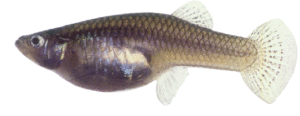Gambusia Affinis (Mosquito Fish)
Gambusia affinis, more commonly known as the Western Mosquito Fish, are a very important part of the district's control efforts IPM (Integrated Pest Management). Starting in May CDVCD supplies the community with FREE Mosquito fish in order to help keep mosquito populations down. We post on the website when we can start giving them away. When the program is set up and ready to go feel free to stop by the building in St. Helens with a small container like a coffee can or small bucket. We'll have a couple available if needed. If you want your gambusia to breed in your designated enclosed habitat please ensure you have both males and females. Females are distinct with a black spot on the posterior of their abdomen and males are a bit smaller (16 to 28 day gestation period = 60 young). This small freshwater fish may be placed in any ornamental pond or watering trough to control populations of mosquitoes (8 to 12 fish per). Additional gambusia will be needed for control in larger bodies of water. Some gambusia have the ability to winter-over in deeper ponds. These fish also feed on zooplankton, beetles, mayflies, mites, and other invertebrates, making mosquitoes only a portion of their diet. *Important note: Gambusia were initially introduced as a control for locations with high mosquito populations. Unfortunately gambusia can be quite detrimental to other fish and amphibian ecosystems. Gambusia fish are prohibited from open water sources and main waterways by the Oregon Department of Fish and Wildlife (OAR 635-007-0501). Gambusia must stay in enclosed systems like ornamental ponds and watering troughs.
Starting in May CDVCD supplies the community with FREE Mosquito fish in order to help keep mosquito populations down. We post on the website when we can start giving them away. When the program is set up and ready to go feel free to stop by the building in St. Helens with a small container like a coffee can or small bucket. We'll have a couple available if needed. If you want your gambusia to breed in your designated enclosed habitat please ensure you have both males and females. Females are distinct with a black spot on the posterior of their abdomen and males are a bit smaller (16 to 28 day gestation period = 60 young). This small freshwater fish may be placed in any ornamental pond or watering trough to control populations of mosquitoes (8 to 12 fish per). Additional gambusia will be needed for control in larger bodies of water. Some gambusia have the ability to winter-over in deeper ponds. These fish also feed on zooplankton, beetles, mayflies, mites, and other invertebrates, making mosquitoes only a portion of their diet. *Important note: Gambusia were initially introduced as a control for locations with high mosquito populations. Unfortunately gambusia can be quite detrimental to other fish and amphibian ecosystems. Gambusia fish are prohibited from open water sources and main waterways by the Oregon Department of Fish and Wildlife (OAR 635-007-0501). Gambusia must stay in enclosed systems like ornamental ponds and watering troughs.
